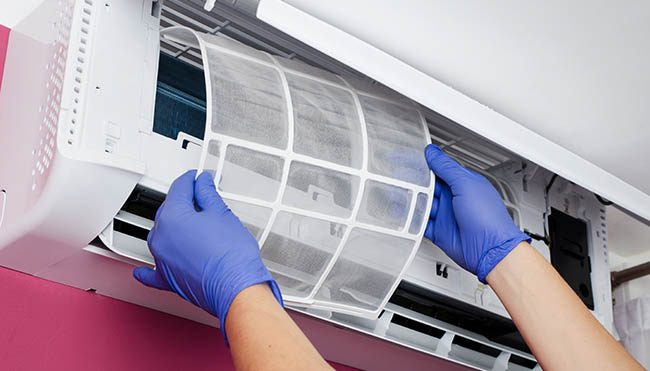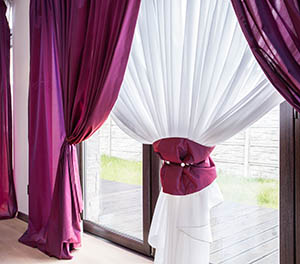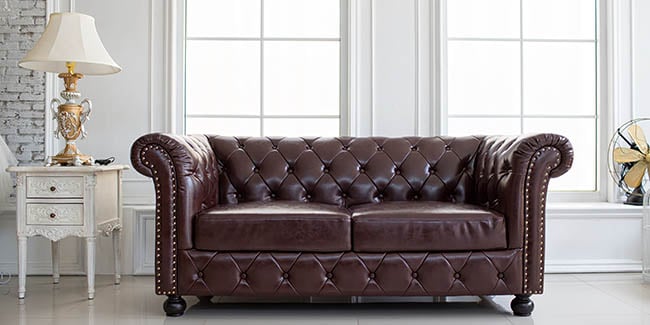
According to the United States Environmental Protection Agency, the average home is subject to a whole slew of indoor pollutants, including dust mites, mold, bacteria, viruses, smoke, pollen, pet dander. You may also need to worry about bothersome gaseous pollutants that come from appliances, vehicle exhausts and tobacco smoke.
Thankfully, ridding your home of allergens is relatively simple when you invest in the right cleaning tools and use common sense. Here are 20 simple ways to reduce home allergens and to make your home a more comfortable, enjoyable place to live.

Use a HEPA Vacuum Cleaner
Replacing your less-healthy vacuum cleaner with a HEPA (high-efficiency particulate air) vacuum cleaner is a great way to trap even more minute particles in your environment without risking reintroduction into the air you breathe.
These allergy vacuum cleaners trap extremely small particles and seal them away using a special HEPA filter to help further reduce your exposure to airborne particles that can contribute to your allergy symptoms. Giving your home a complete sweep with a HEPA vacuum is a great way to eliminate many of these particles that settle in your rugs, carpeting, window treatments and on solid surfaces.

Limit Where Your Pet Can Go
 This is a tough one for pet-loving allergy sufferers, but sometimes it’s necessary. If you struggle from allergic attacks associated with pet dander, consider limiting your pet’s access to the bedroom. If that’s not possible, at least consider restricting them from sleeping on the bed with you at night.
This is a tough one for pet-loving allergy sufferers, but sometimes it’s necessary. If you struggle from allergic attacks associated with pet dander, consider limiting your pet’s access to the bedroom. If that’s not possible, at least consider restricting them from sleeping on the bed with you at night.
When you sleep, you unknowingly breathe in all of your bedroom’s most allergy-worsening particles. Therefore, keeping the bedroom allergen-free can go a long way in reducing the symptoms you experience throughout the day.

Invest in an Air Purifier
Air purifiers work by removing contaminates (including the most common allergy triggers, like dust mites, pollen and dander) from the air you breathe. You’re able to eradicate your home from these particles when you regularly change the filter on your air purifier as needed.
Air purifiers come in a huge variety of shapes and sizes, from allergy purifiers that target airborne particles like pet dander, mold spores, dust mites, pollen and other common household air pollutants to MCS air purifiers that help greatly reduce the amount of chemicals and substances in your home that can worsen your MCS symptoms.

Change Your Filters
Your home and various appliances throughout it rely on air filters in order to help keep the air and environment clean of excessive dust, dirt and pollutants. Make sure to regularly change the filters in your HVAC system (and make sure you’re using HEPA filters) via hvac contractors that provide HVAC Installation Glendora CA, as well as your air purifier and car’s air filters.

HVAC filters, also known as furnace filters, are designed to clean dust, dirt and debris from your HVAC’s system in order to keep your home’s air as pure as possible. These filters come in both permanent and disposable options to ensure that you’re able to properly clean and maintain them for better home air quality.

Replace Your Mattress
If possible, replace your mattress at least every 10 years. Your mattress is the most hospitable place in your home for the presence of allergy-exacerbating dust mites, and these stubborn little creatures just so happen to thrive in old mattresses. You’ll sleep easier knowing that you’re not breathing in allergy-causing dust mites while you’re getting a good night’s rest.
Remember to always do a deep, thorough vacuum of the area surrounding your bed anytime you change or flip your mattress. This will fully remove all of the dust mites that may have been transferred during replacement.

Protect Bedding from Dust Mites
You should always use a dust mite mattress cover to prevent the presence and proliferation of these pesky bugs. Allergen-blocking bedding and mattress covers are made of tightly woven fabric that prevents dust mites from escaping from the mattress or bedding.
We highly recommend picking up a dust mite cover for your box spring, as well. Don’t forget to follow steps on how to limit your home’s exposure to dust mites for more suggestions on how to keep your bedroom and home free of difficult irritants.

Wash Bedding Once a Week
 In order to ensure that your bedding is not collecting skin flakes — i.e., dust mite dinner — make sure you get into the habit of washing all of your bedding once a week. We highly recommend washing all of your home’s sheets, pillow cases, blankets, comforters and even toss pillows on a hot cycle (about 140 degrees) once per week. This can effectively kill dust mites, bed bugs and other pests while removing allergens that may become trapped in the fibers.
In order to ensure that your bedding is not collecting skin flakes — i.e., dust mite dinner — make sure you get into the habit of washing all of your bedding once a week. We highly recommend washing all of your home’s sheets, pillow cases, blankets, comforters and even toss pillows on a hot cycle (about 140 degrees) once per week. This can effectively kill dust mites, bed bugs and other pests while removing allergens that may become trapped in the fibers.

Wash Bedding with a Mite Control Cleaner
If you haven’t noticed by now, keeping your bedding clean is one of the most important parts of ensuring that your home is free of pesky allergens. We highly recommend occasionally using a dust mite laundry product, such as the Mite-y Clean Laundry Additive, to help alleviate those allergy symptoms associated with the presence of dust mites.
This product and other similar laundry additives are designed to remove dust mites from bedding without having to run your laundry on a hot cycle. In other words, it allows you to wash your bedding with the rest of your laundry and still eradicate mites.

Clean Under Surfaces
It’s easy to forget about those areas of your home that you never see — beneath your sofa, chairs, appliances rugs and floor mats, for example — but these are some of the sneakiest hideaways for allergy-causing particles. Try to integrate cleaning beneath the surface into your once-monthly deep cleaning regimen in order to get rid of those hard-to-spot allergy particles.


Be Hyper-Vigilant About Moisture
If you live in an old home or one where the basement isn’t fully waterproofed, you can invest in a relatively affordable moisture meter do measure the levels of moisture in your home. A good rule of thumb is to keep the air in your home at 50 percent or below. Control moisture (and, in turn, limit the growth of mold and mildew) by installing dehumidifiers throughout your home, especially in wet areas like the basement. If you find a leak in your plumbing, call the experts immediately.

Replace Blinds with Draperies
 As convenient as blinds may be in terms of privacy and light control, they’re not the best choice for allergy sufferers. That’s because they’re typically made of plastic or wood, which can attract those small airborne particles and reintroduce them back into the air you breathe when you adjust the blinds. Opt instead for fabric window treatments with a convenient drapery rod or hook system so that you can easily remove them and wash them in your regular laundry.
As convenient as blinds may be in terms of privacy and light control, they’re not the best choice for allergy sufferers. That’s because they’re typically made of plastic or wood, which can attract those small airborne particles and reintroduce them back into the air you breathe when you adjust the blinds. Opt instead for fabric window treatments with a convenient drapery rod or hook system so that you can easily remove them and wash them in your regular laundry.

Opt for Hard-Surface Floors Over Rugs and Carpeting
Carpeting is a relatively affordable way to add comfort and warmth to your home, but unfortunately, it’s not the best choice for allergy sufferers. Not only does carpeting tend to invite a host of minute airborne particles to settle in your flooring, but it also gives off harmful chemical emissions that can trigger some allergies. If you have to install carpet, make sure to follow the EPA’s carpet installation guidelines: introduce plenty of fresh-air ventilation and, for severe sufferers of chemical allergies, avoid using the room for at least 72 hours.

Keep Windows Closed or Use Window Filters
It can be very tempting to let the sweet, fresh air in on a particularly mild fall or spring day. Unfortunately, when you keep your windows open, you’re inviting plenty of allergens to take respite in your home.
The good news is that you can use handy products like window filters to curb allergy symptoms. These filters allow fresh air to pass through, while limiting access to the most frustrating allergy triggers, including ragweed pollen and dust.

Opt for Leather, Wood or Vinyl Furniture
One of the simplest ways to allergy-proof your home and to limit the existence of allergens in your living spaces is to ditch your regular fabric-upholstered furniture in place of easy-to-clean furniture made from materials such as leather, wood, vinyl, metal or plastic that you can quickly wipe down as needed. These materials are less likely to collect (and trap!) small allergens which can aggravate allergy symptoms.


Avoid Using a Wood-Burning Stove or Fireplace
If you have an old home, consider upgrading your wood-burning fireplace to a natural gas option, in order to avoid the introduction of small particles and chemicals into the air you breathe. We also recommend avoiding the use of kerosene lamps and gas stoves, since these appliances can produce nitrogen dioxide and other pollutants that can be very aggravating to allergy sufferers.

Use Anti-Allergen Cleaning Solutions
Before you invest in a high-quality anti-allergy cleaner, make sure to do a clean sweep beneath the sink to get rid of any allergy-causing cleaning products. Some cleaners have chemicals that can irritate your airways and worsen your allergy symptoms.
Instead, use products throughout your home that are safe for allergy sufferers. You can even pick up specific anti-allergen cleaning sprays that are uniquely designed to thoroughly clean and remove allergens from hard surfaces, as well as upholstery, carpeting and window treatments.

Invest in a Steam Cleaner
Steam cleaners sanitize and clean your home without the presence of any aggravating cleaning agents. Instead, they use the cleanest and purest cleaning agent available — water — to eradicate your home from allergy-triggering particles, as well as dust and chemicals.
You can use a steam cleaner to clean hard-surface flooring, walls, showers, upholstered furniture, draperies and much more. These ultra-healthy cleaning tools are one of the best eco-friendly options for getting rid of dust mites, dust mite waste, pollen, dander and other allergens that get trapped inside the fibers of your furniture, flooring and more.

De-Clutter Surfaces
 The more surfaces in your home, the more dust and allergens will settle. In order to help reduce the presence of airborne particles that can worsen your allergy symptoms, try to take a minimalist approach with décor by reducing clutter and limiting accents only to the essentials. If you have a lot of stuff you want to get rid of, you may order online a roll-off dumpster.
The more surfaces in your home, the more dust and allergens will settle. In order to help reduce the presence of airborne particles that can worsen your allergy symptoms, try to take a minimalist approach with décor by reducing clutter and limiting accents only to the essentials. If you have a lot of stuff you want to get rid of, you may order online a roll-off dumpster.
Organizing is also a great way to make sure that your environment isn’t hospitable to allergens. Place all children’s toys, stuffed animals, books, magazines and seasonal home accents in large plastic storage bins when they’re not being used.

Try Allergen-Reducing Houseplants
Plants are Earth’s original air purifiers, so it makes sense that introducing a few houseplants into your environment could effectively help clean your home’s air of allergy triggering particulates. There are a wide range of beautiful, fresh house plants that you can use to relieve allergies.
For cleaner air in your home, choose general air purifying plants like areca palm, lady palm, bamboo palm and dracaena. Make sure to treat your indoor plants like you would knickknacks and home décor by regularly wiping down the leaves with a damp cloth in order to eradicate dust and other airborne particles.

Clean Ceiling Fans and Box Fans Before Use
Before the weather gets hot and you dig your fans out of storage, make sure to give them a thorough deep clean with a microfiber cloth and soapy water or a gentle cleaning agent. And, it may seem obvious, but make sure that you’re fully dusting and wiping down your ceiling fan’s blades before you turn on your fan after long periods of time. You may also inspect your ceiling fan and see if it needs a repair. These ceiling fan services in Spokane Valley, WA can come and help you. This will help ensure that the dust and allergens that have settled on the surface don’t swirl into the air you breathe.
